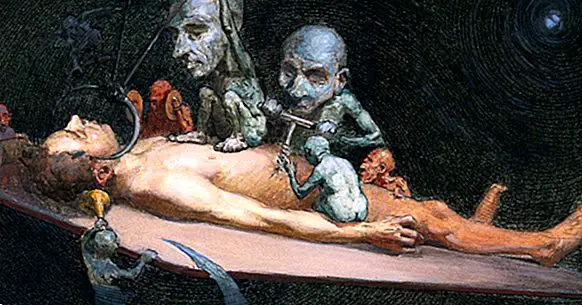The 6 levels of loss of consciousness and associated disorders
There is a wide variety of pathologies that can arise from an injury to the human brain. One of the effects that these disorders can have is the decrease in the level of consciousness .
We'll see now the different degrees in which a person can lose consciousness because of a pathology, and why this is believed to occur. However, before speaking properly of this type of decrement and therefore the appearance of disorders, it is convenient to establish that we understand by conscience.
- Related article: "Types of brain waves: Delta, Theta, Alpha, Beta and Gamma"
What do we mean by consciousness?
The capacity that allows us to obtain knowledge of ourselves and the environment that surrounds us is called consciousness. And the degree that a person can have of the same will be determined by what he does or stops doing a neural system known as reticular formation, which is distributed by the brainstem, the diencephalon and the cerebral hemispheres.
Through the Ascending Reticular Activating System (SARA), reticular formation controls the activity of cortical and thalamic neurons , this being the key to wakefulness (being awake), all thanks to the bidirectional stimulation that exists between the cortical and reticular areas.
Levels of loss of consciousness
There are different phases with respect to the loss of knowledge , some of greater fatality than others. Let's review them:
1. Confusion
In this phase the damage is relatively slight , although despite this the person can not reason quickly and clearly and the thought is slow.
2. Obnubilation
In this state the person is sleepy, and even falls asleep , although it is not the time or the right place. When she is awake she is unable to stay alert, and her movements are very restricted. If you can wake up when you come in contact with stimuli, and is able to emit reactions to verbal or painful stimulation.
3. Stupor or semi-coma
Here the individual affected by the accident or pathology he only manages to wake up if he is presented with repetitive and intense stimuli , but the answers it produces will not be coherent and will be slow. When confronted with painful stimuli, it faces them avoiding them. There is no toilet training and motor activity is nil.
4. The coma
Etymologically, coma means deep sleep. It is a pathological state that presents a great loss in the level of consciousness, it is identified as a stage in which the individual can not feel or wake up, does not produce any verbal or motor response to external stimuli, however penetrating and painful they may be.
It should be noted that, in the coma, what causes the loss of consciousness is the product of not supplying blood to the brain for 20 or more seconds , or when the blood perfusion is below 35ml / minute for every 100 grams of brain mass. You enter a state of physiological savings, so the brain seeks to reduce energy consumption (use less glucose, for example) to avoid further damage to brain cells
5. Brain death
It is the last phase with respect to the loss of consciousness, in this case there is no record of brain activity nor in the brainstem, because there is a global infarction and total paralysis of cerebral blood flow. The breath is suspended (apnea), and can only be maintained by artificial means.
Pathologies that cause them
This type of disorders can arise from very different causes . For example, product of a traumatic brain injury, vascular disorder, encephalic tumor, epilepsy, excessive consumption of alcohol and a very long etcetera.
Fundamentally, any disease or accident with potential to damage the diencephalon or brainstem has a high chance of producing coma or brain death, while less severe degrees of loss of consciousness can be produced by more superficial lesions.
Some patients remain in a coma for weeks, months and even years, and enter in a state known as a vegetative state , which is characterized by the fact that autonomous functions such as heart rate, respiration, regulation of temperature and blood pressure are preserved, but not the reasoning, behavior or voluntary interaction to the outside.
Bibliographic references:
- Antonio, P. P. (2010). Introduction to neuropsychology. Madrid: McGraw-Hill.



















